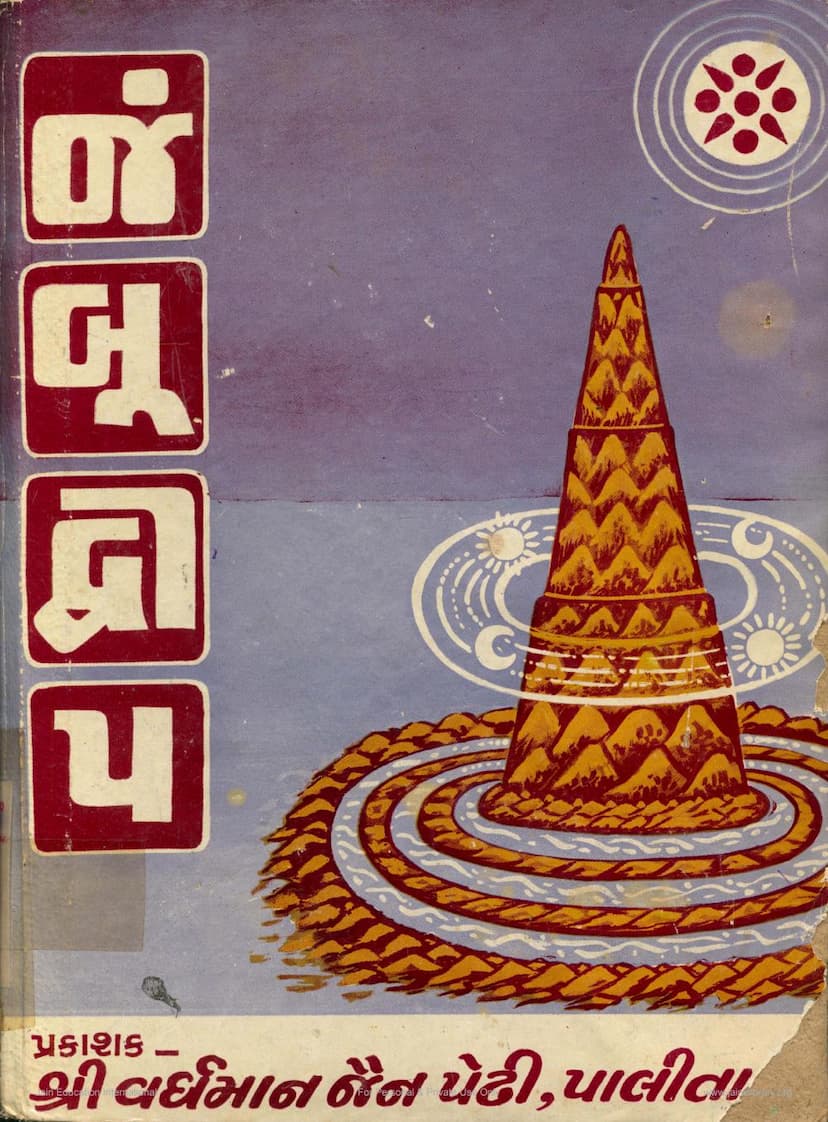Jambudwip Part 01
Added to library: September 2, 2025

Summary
Here is a comprehensive summary of the provided Jain text, "Jambudwip Part 01," based on the content of the pages you've shared:
Title: Jambudwip Part 01 Author/Publisher: Vardhaman Jain Pedhi, Palitana Catalog Link: https://jainqq.org/explore/005567/1
Overview:
This publication, "Jambudwip Part 01," is presented by Shree Vardhaman Jain Pedhi, Palitana. It is a bi-annual publication (appearing every six months) in Gujarati, Sanskrit, Hindi, and English, aiming to provide knowledge and insights on Jain cosmology, philosophy, and science. The publication is part of the "Shree Jambudweep Yojana" project, which is developing a large-scale physical representation of Jambudweep, the central continent in Jain cosmology. This first volume focuses on presenting various scholarly articles that bridge the understanding between traditional Jain knowledge and modern scientific perspectives.
Key Themes and Content:
The publication addresses several critical areas, attempting to reconcile or present Jain cosmology and philosophical concepts alongside modern scientific theories. The main themes covered in this volume include:
- Jain Cosmology (Jambudweep): A significant portion of the publication is dedicated to explaining the Jain concept of Jambudweep, the central continent of the universe according to Jainism. It details the arrangement of continents and oceans, their dimensions (in yojana), the various mountains, rivers, and regions within Jambudweep, and the unique characteristics of different oceans (e.g., their water taste, inhabitants). The text emphasizes that Jambudweep is a vast and intricately described cosmological model within Jain scriptures.
- Reconciling Jainism with Modern Science: Several articles explore the intersection of Jain teachings with modern scientific discoveries. This includes discussions on:
- The Shape and Motion of the Earth: Articles examine the Jain perspective on the Earth's form (contrasting it with modern spherical Earth theories) and its movements, including discussions on the nature of day and night, and the apparent motion of celestial bodies. Some articles present arguments that challenge the modern scientific consensus on a rotating, spherical Earth, drawing upon traditional Jain texts and interpretations.
- Astronomy and Celestial Phenomena: The publication delves into Jain astronomical calculations, including concepts like the 'double sun' theory (Surya-dwaya-Siddhanta) discussed in texts like Surya Prajnapti. It analyzes ancient Jain astronomical observations and compares them with modern astronomical findings, suggesting potential parallels and insights from Jain tradition regarding celestial bodies, distances, and cosmic phenomena like black holes ('Krishna Gat').
- The 'Zetetic' Method: One article introduces and advocates for the "Zetetic" method of inquiry, which emphasizes empirical observation and rigorous questioning of accepted theories, particularly in contrast to what the author terms "theoretic" or speculative approaches. This method is applied to challenge modern scientific notions about the Earth.
- "Did the Spaceship Apollo Land on the Moon?": A significant section critically examines the Apollo moon landing, presenting arguments from Muni Sri Abhaysagarji Maharaj Gani that question the official scientific narrative. The arguments focus on perceived inconsistencies in scientific explanations regarding the spaceship's trajectory, communication, the environment of the moon, and the interpretation of lunar data.
- Jain Jyotisha Vijnana (Jain Astronomy): Articles explore the scientific basis and historical context of Jain astronomy, highlighting its sophisticated calculations, unique concepts (like the double sun theory, mandalas, and detailed measurements), and its potential to fill gaps in the understanding of ancient Indian astronomy. It discusses the importance of studying original Jain texts for a proper understanding of this field.
- Jain Philosophy and the Path to Liberation (Moksha): The publication includes an article on the "Jaina-Abhimata-Mukt Marga" (The Jain Path to Liberation), which elucidates the Jain path to salvation. This path is described as being based on Samyak Darshan (right faith), Samyak Gyan (right knowledge), and Samyak Charitra (right conduct). The article emphasizes that these three are interconnected and collectively form the true path to liberation, contrasting this with partial or incomplete approaches. It also highlights the importance of understanding the self (Atman) and the nature of reality in achieving liberation.
- The Significance of Jambudweep: The publication underscores the profound significance of Jambudweep in Jainism, not just as a cosmological concept but as a sacred land where significant spiritual events and the presence of Tirthankaras and spiritual teachers are believed to occur. The ongoing "Shree Jambudweep Yojana" aims to make this cosmic vision tangible for devotees.
Key Contributors and Support:
The publication is supported by a "Prakaranik Mandali" (Guiding committee) of esteemed Muni-rajash (monks) and an editorial board comprising scholars from various institutions. The publisher expresses gratitude to many individuals and institutions for their support, particularly highlighting the contributions of Dr. Rudradev Tripathi, Dr. Prahladbhai G. Patel, and Pandit Ratilal Ch. Doshi for their editorial and review work.
Overall Purpose:
"Jambudwip Part 01" serves as a platform to disseminate Jain knowledge, encourage critical thinking, and foster a dialogue between traditional Jain wisdom and modern scientific understanding. It aims to re-evaluate scientific claims through the lens of Jain philosophy and cosmology, encouraging readers to seek deeper truths beyond conventional narratives. The publication also serves as a promotional tool for the larger Shree Jambudweep Yojana project in Palitana.